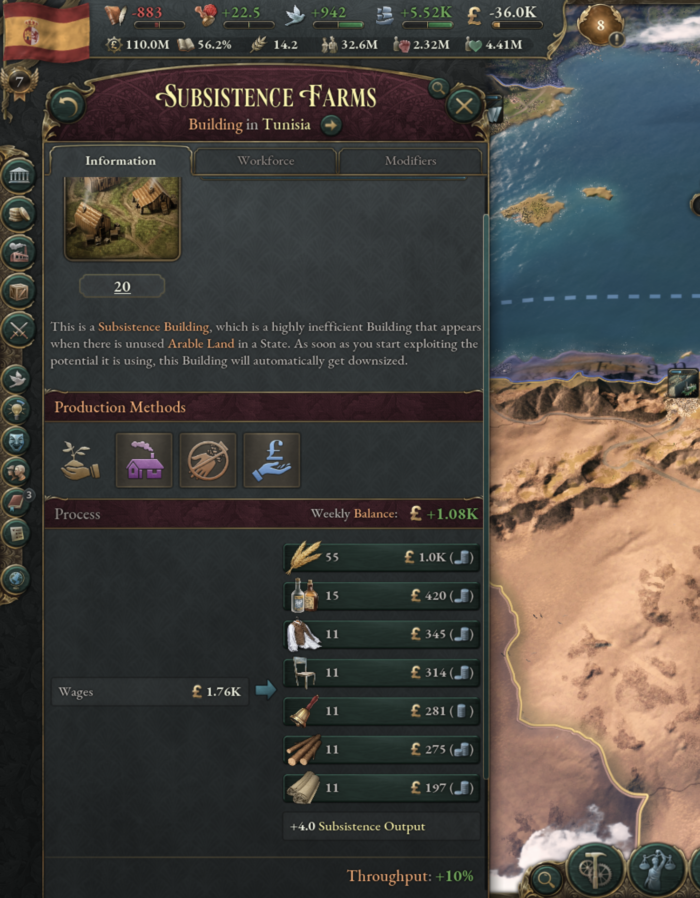Subsistence farms are a major part of the early economy in Victoria 3. Rural populations cultivate small plots of land for low wages just to feed themselves. Here is how to understand and reduce dependence on subsistence farming as you industrialize your country…
What are Subsistence Farms?
Subsistence Farms represent large rural populations that cultivate small plots of land primarily to feed themselves and their families. Each level of subsistence farm buildings like paddies, orchards, and pastures employs thousands of pops.

For example, subsistence rice paddies employ 10,000 pops per level. Subsistence orchards and farms employ around 5,000 pops each. These pops are paid extremely low wages, but their basic needs are met through their agricultural yields.
Subsistence farms act as a buffer against unemployment and unrest in early game rural areas. Without the availability of other jobs, they absorb large numbers of unskilled people who would otherwise be unemployed and angry.
Pros of Subsistence Farms:
- Prevent unemployment by employing large rural populations. Avoiding mass unemployment helps contain unrest.
- Produce goods like clothes, furniture, liquor and services that can’t be made on regular farms. Subsistence buildings with “home workshops” methods generate more diverse economic outputs.
- Don’t require educated pops, so they can absorb completely unskilled labor and avoid mass poverty.
- Provide a basic standard of living for rural pops who might otherwise struggle to find work.
Cons of Subsistence Farms:
- Pops earn very little. This limits economic growth, industrialization, and tax revenue for the state.
- Take up arable land that could be used for more profitable cash crop farms and plantations.
- Empower aristocratic landowners who profit from cheap rural labor in subsistence farming areas.
- Prevent promotion of rural pops into more skilled labor like craftsmen, clerks, and professionals.
Problematic combination explained:
Pros and Cons make a great combo, because they make you occupied while playing Victoria 3. You should see that Subsistence Farms also produce non-farms goods such as clothing, furniture, liquor and services. However, if you replace these Farms, your people will lack these goods a lot. That is why you need to expand your land properly.
All this should be a problem when you want to increase your GDP and when you need more people working in industry. If you don’t have a strong construction sector and private construction is not working well, then you can’t just replace all subsidized farms with other buildings. It is because your pops will be missing the goods. According to that, you need to focus on buildings that produce clothing, furniture, liquor and services.
Another interesting problem is in big countries, where subsistence rice paddies are built. These should employ 10,000 pops. Removing your Subsistence Farms could cause problems for your country because most of the buildings don’t have enough space for employees. Maybe in Europe it makes a lot of sense to get rid of Subsistence Farms and focus a lot on optimizing production (i.e. having more people out of work so they can be employed). However, in the case of for example India and China, the results may not be that promising.
Reducing Subsistence Farms:
As your nation industrializes, you will want to move the population away from low-productivity subsistence agriculture. Within this we have found possible approaches for you:
- Create new job positions in mines, lumber camps, factories, and farms that pay better wages than subsistence farming. Any better paying job will attract pops.
- Enact education reforms like public schools to increase literacy. Educated pops are more likely to take jobs in the industry. Fund education institutions to train more skilled pop types.
- Improve living standards through social reforms and adequate taxes to encourage subsistence farmers to seek better work.
- Avoid labor-reducing production methods that would displace subsistence farmers and cause unemployment.
- Be patient, as transitioning from a rural subsistence economy takes decades and requires social mobility.
With urbanization and industrialization, dependence on subsistence farms will naturally decline over time. Following these tips can help speed up this economic transition in your country. For more tips, you should see my article How to reduce peasants in Victoria 3?